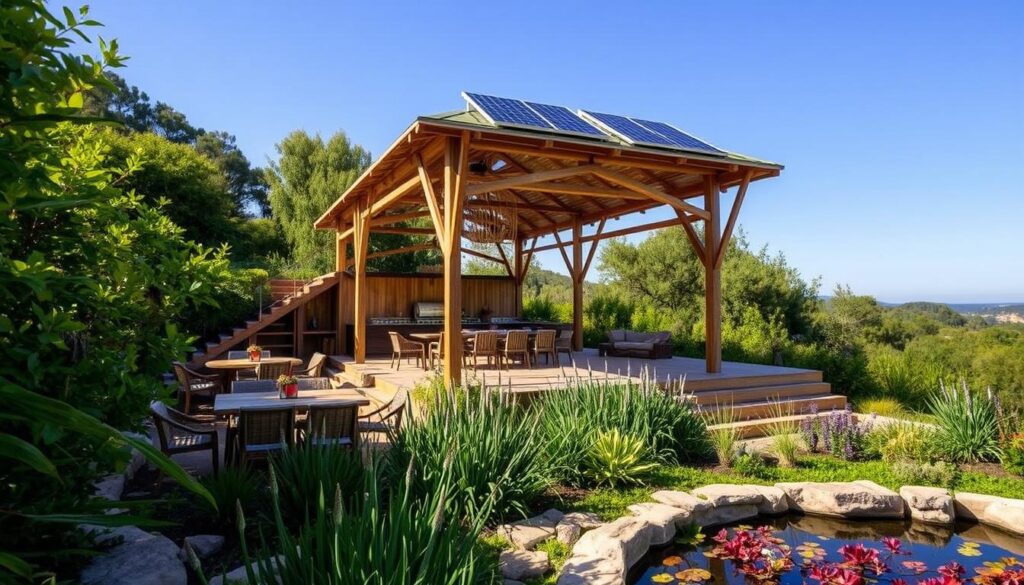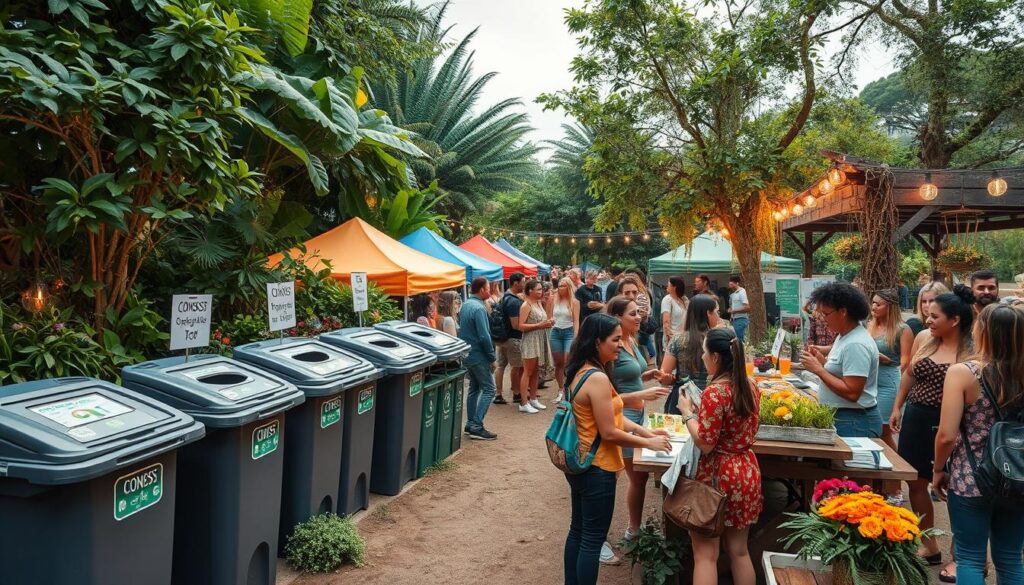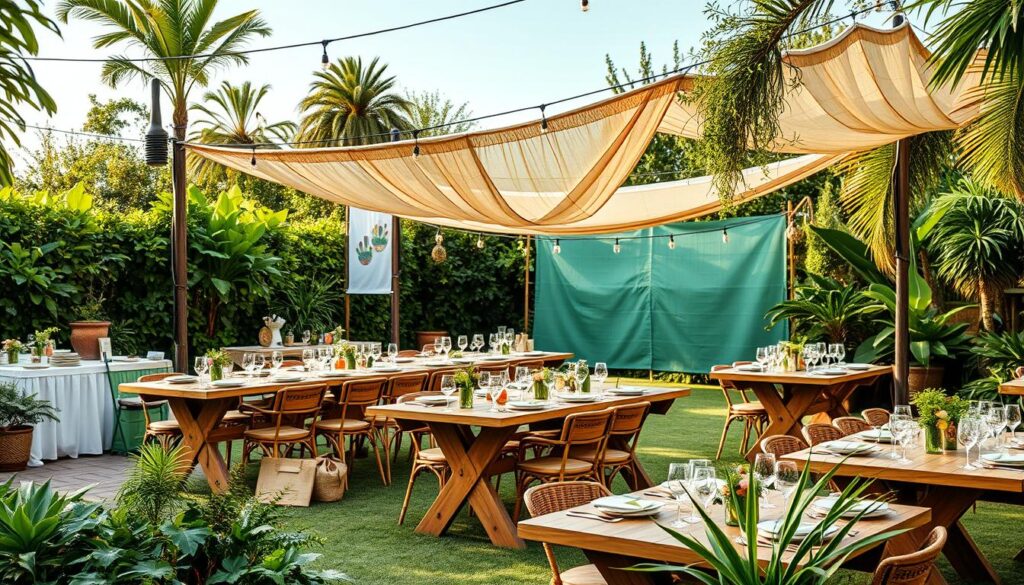Are you passionate about the environment? Or have attendees asked you to be more eco-friendly? Planning sustainable events is key for organizers, with 61% aiming to do so this year. It’s easy to lessen your event’s environmental impact with a bit of thought.
This article will guide you on how to make your eco-friendly events, sustainable gatherings, and green meetings better. You’ll learn how to make them more environmentally conscious, carbon-neutral, and zero-waste.
Key Takeaways
- 61% of event organizers are planning to make their events more eco-friendly this year.
- Sustainable event planning involves reducing environmental impact through waste management, energy efficiency, sustainable sourcing, and more.
- Choosing an eco-friendly venue and sustainable catering options are crucial for environmentally-friendly festivities and green event planning.
- Promoting sustainable transportation and engaging attendees in eco-conscious event hosting and responsible event practices are key to successful eco-positive event experiences.
- Measuring and reporting the sustainability impact of your event is essential for continuous improvement towards carbon-neutral events and zero-waste events.
Understanding Sustainable Events
Sustainable event management means planning events that don’t harm the environment. It’s about using resources wisely and being kind to nature. More people now want to celebrate in ways that are good for the planet.
What Are Sustainable Events and Their Standards?
Sustainable events follow certain rules to lessen their environmental harm. These rules include:
- Waste reduction and recycling programs
- Energy-efficient technologies and renewable energy sources
- Water conservation strategies
- Sustainable sourcing of materials and catering
- Promoting alternative transportation options for attendees
- Minimizing the carbon footprint of the event
These steps help make events better for our planet.
Why Sustainable Event Management Matters
More and more, people want events that are good for the environment. 63% of event planners aim for planet-friendly parties and low-carbon events. This is because they care about the planet and want to offer nature-inspired soirees that appeal to 69% of attendees.
By choosing sustainable options, event planners can help the planet. They also show they care about eco-conscious celebrations and sustainable festivities.
Setting Goals for a Sustainable Event

Starting with eco-friendly events means setting clear goals. First, look at what you’re doing now. Do you use a lot of single-use plastics? Do people mostly drive to your event? Is there a lot of food left over?
Knowing this helps you make better choices. It gives you the info you need to plan better.
Defining Eco-Friendly Objectives
It’s important to say what you want to achieve. You might want to cut down on carbon, reduce waste, and entertain responsibly. Use tools like those from myclimate to help plan your event.
This way, you can set goals that you can measure. Your event will be more in line with caring for the environment.
Categorizing Sustainability Goals
- Work towards events that don’t harm the planet through smart planning.
- Find ways to cut down on waste and make your event better for the environment.
- Look for vendors who share your eco-friendly values.
By setting clear goals and organizing them, you can make better choices. This leads to events that are good for the planet and fun for everyone.
Choosing an Eco-Friendly Venue

When planning environmental events, eco-conscious festivals, or planet-friendly parties, picking the right venue is key. It helps lower your low-impact events’ carbon footprint. Look for sustainable event venues with green spaces and eco-friendly locations.
LEED-certified venues are a great choice. They have the Leadership in Energy and Environmental Design (LEED) certification. This shows they care about energy, water, waste, and the environment. Hosting your event at a LEED-certified venue means it will be eco-friendly.
| Sustainability Metric | LEED-Certified Venue Performance |
|---|---|
| Energy Efficiency | LEED-certified venues use 25-30% less energy than usual, cutting down your event’s carbon footprint. |
| Water Conservation | They save water with low-flow fixtures and rainwater harvesting, keeping this resource safe. |
| Waste Management | They have recycling and composting, sending less waste to landfills. |
| Indoor Air Quality | They focus on healthy air with better ventilation and materials that don’t harm the air. |
When finding a sustainable event venue for your environmental events, eco-conscious festivals, or planet-friendly parties, look for LEED certification. Choosing a green event space that cares about the environment helps reduce your low-impact events’ carbon footprint. It makes your event a responsible choice for your guests.
Sustainable Catering and Food Options

Planning an eco-friendly event means focusing on sustainable catering. Choosing plant-based options, locally sourced ingredients, and zero-waste practices helps a lot. This way, events can greatly reduce their environmental footprint.
Reducing Food Waste
Food waste is a big problem at many events. To fix this, it’s key to guess the right amount of food. Knowing what guests can eat helps too.
Any leftover food should be donated. This way, it doesn’t go to waste.
Plant-Based and Local Ingredients
Plant-based menus are better for the planet. They need less water, land, and energy than meat.
Using locally grown and seasonal ingredients also helps. It cuts down on transportation emissions. Sustainable seafood is another good choice, thanks to groups like the Marine Stewardship Council (MSC).
Adding sustainable catering practices makes events even greener. Using energy-efficient stuff and water-saving methods is smart. So is using reusable or compostable items.
By doing these things, events can have zero-waste catering. This makes their food and drinks better for the planet.
Eco-Friendly Events: Waste Management

Hosting zero-waste events is key to being responsible. When planning, use waste reduction strategies and recycling. Also, choose compostable materials to lessen your impact on the environment.
Reducing, Reusing, and Recycling
Try to use materials that can be recycled or reused. Single-use items create a lot of waste. So, pick reusable options instead.
Ask people to return items like lanyards or badge covers. This way, they can be used again. Make recycling easy by labeling bins clearly.
Compostable Materials
Using compostable materials like plant-based or bamboo cutlery is also good. It helps avoid landfills and supports green event practices. By using these, you help reach zero-waste goals.
| Event Waste Management Strategies | Potential Impact |
|---|---|
| Transitioning to digital marketing and event information | Around 40% reduction in paper waste |
| Serving food in reusable or compostable materials | Up to 50% reduction in environmental impact |
| Encouraging eco-friendly transportation for attendees | About 25% of attendees use sustainable modes |
| Providing clearly labeled recycling and compost bins | Around 85% of guests actively participate in waste management |
By using these strategies, you can make your event more sustainable. This aligns with zero-waste goals.
Energy Efficiency and Conservation
When planning an eco-friendly event, focus on energy efficiency and conservation. Venues, lighting, and power sources greatly affect your event’s environmental impact.
Choose a venue that values sustainability. Look for places with LEED certification. These buildings use energy-saving designs and often run on renewable energy like solar or wind.
Lighting is key. Use energy-efficient lighting like LED bulbs. They use less power and make less heat than old bulbs. Try to use natural lighting too, to cut down on electricity use.
For sound and staging, think about using renewable energy. Set up kinetic dance floors or walkways. They turn people’s movement into electricity, making your event green and fun. You can also use pedal-powered setups for attendees to cycle and generate power.
By focusing on energy efficiency, you can make your event carbon-neutral. This shows your dedication to the environment and meets your sustainability goals.
| Sustainability Measure | Impact |
|---|---|
| Choosing a LEED-certified venue | Reduces energy consumption and carbon emissions |
| Implementing energy-efficient lighting | Lowers power demand and heat generation |
| Utilizing renewable energy sources | Generates sustainable event power |
| Incorporating kinetic dance floors | Converts attendee movement into renewable energy |
Promoting Sustainable Transportation

When planning an eco-friendly event, it’s key to encourage green travel. Too many cars can harm the environment. So, it’s important to promote greener ways to get there.
Let people know about bike or scooter-sharing programs. This makes it easy to ditch the car and travel green. Also, tell everyone about public transit incentives like buses, trains, and subways.
For those who must drive, push for carpooling initiatives. Help people find rides with others or use green rideshare apps. Offering electric shuttle services to and from the event also helps. This supports sustainable attendee travel and cuts down on low-carbon event logistics.
By supporting these green travel options, you can greatly reduce your event’s carbon footprint. This helps make the future greener.
Eco-Friendly Events: Green Procurement

Planning an eco-friendly event means working with eco-conscious vendors and sustainable event suppliers. These partners help make your event green. By picking green event procurement and ethical event sourcing, your event will be truly eco-friendly.
First, make a list of what you need from your suppliers. Look for recycled event materials and environmentally responsible partnerships. Choose suppliers that offer reusable decorations and props. This cuts down on waste and supports a circular economy.
- Dencowear increased recycling by 300% in three years, showing big progress in waste recycling.
- They cut energy use by 12% with low-emission lighting, showing a big commitment to saving energy.
- By working from home and office, they reduced travel emissions by 17%, cutting down on carbon footprint.
| Sustainability Practices | Impact |
|---|---|
| Strategic collaboration with courier partners like DPD and Royal Mail | Minimizing carbon emissions in transportation |
| Enforcing a national living wage commitment throughout the supply chain | Ensuring compliance with legal standards and supporting fair wages |
| Maintaining a zero-tolerance waste policy, focusing on waste minimization and recycling initiatives | Reducing environmental impact across operations, including packaging and manufacturing |
By picking eco-conscious vendors and sustainable event suppliers, you create a green partnership. This makes your event memorable and eco-friendly for your guests.
Virtual and Hybrid Event Options
The event world is changing fast. Now, we have virtual and hybrid events as green choices instead of old-school meetings. These new ways cut down on carbon and bring many benefits for our planet and event planning.
Online events mean no travel for guests, which cuts down on pollution. Using digital event platforms, planners can cut down on paper and make things more efficient. This saves money and helps the planet.
Hybrid events mix online and in-person parts. They let more people join in while still being kind to the earth. Software helps make these events smooth and paperless.
| Sustainability Benefit | Virtual Events | Hybrid Events |
|---|---|---|
| Reduced Carbon Emissions | ✓ | ✓ |
| Paperless Operations | ✓ | ✓ |
| Wider Audience Reach | ✓ | ✓ |
| Improved Resource Efficiency | ✓ | ✓ |
Choosing virtual and hybrid events lets planners make greener, more responsible events. These options are good for the planet and save money. They’re becoming a top pick for event pros.
Engaging Attendees in Sustainability
Getting your attendees involved in your event’s green efforts is key. It helps everyone feel like they’re part of something big. Teach them about the sustainability education you’ve put in place, like recycling and using eco-friendly materials. Encourage them to join in by bringing their own water bottles or using public transport.
Studies show that green events boost attendee engagement and work performance. They also help cut down on waste and save resources. This makes your event a step towards a greener future.
Fostering Engagement through Interactive Experiences
To get people excited about zero-waste event initiatives, add fun, interactive parts. For instance, have a recycling station where people can learn about sorting waste. Or, create a “sustainability scavenger hunt” to highlight your event’s green features.
This way, you make sustainability fun and meaningful. It helps your attendees connect with your event’s environmental awareness goals on a deeper level.
| Sustainability Integration Levels | Percentage of Event Professionals |
|---|---|
| Incorporate sustainability into every program | 14% |
| Rarely include sustainability practices | 25% |
| Incorporate sustainability “most of the time” | 47% (North America) |
| Incorporate sustainability “most of the time” | 76% (International) |
By getting your attendees involved in sustainability education, you make a real difference. You inspire them to keep up their eco-friendly habits even after the event is over.
Measuring and Reporting Sustainability Impact
It’s key to track the environmental impact of your events. Many tools help event planners measure carbon footprint and waste. They show how eco-friendly your events are.
Tools like SAM, TRACE, and Proseed help a lot. They measure carbon from travel, food, and more. They also give tips to reduce carbon and let you download reports.
Using these tools is vital. They help you see how you’re doing and show you care about the planet. By tracking your ESG data, you can make better choices. This helps lower your carbon footprint and waste.
Making events sustainable is good for business too. Brands that focus on sustainability grow faster. By showing your sustainable event reporting, you can be seen as a leader. This builds trust with your audience.
Having a solid plan for measuring sustainability is key. It shows your progress and impact. By working with partners who care about the planet, you can make a big difference. This helps your brand and community in the long run.
Conclusion
Planning sustainable events is doable and rewarding for event planners. By using eco-friendly event management in all parts of planning, you can lessen your environmental footprint. This makes your events memorable and environmentally responsible for everyone.
Start small and aim for realistic goals. Keep working to get better at green event best practices. This way, you can host planet-conscious events that are fun for guests and good for the planet.
By choosing sustainable ways, you’ll cut down on carbon emissions. You’ll also attract more eco-aware customers. This is great for environmentally conscious companies.
The event world has a big chance to make a difference. By taking on this challenge, event planners can help the environment. They can also give guests unforgettable experiences that show they care about our planet.
FAQ
What are sustainable events and why do they matter?
Sustainable events aim to reduce harm to the environment. They plan carefully to be eco-friendly. This is key as people want to lessen the environmental impact of gatherings.
How do I set eco-friendly goals for my event?
First, look at how your event affects the environment now. Then, set goals like using less plastic or more green energy. Break down your goals into areas to help plan better.
What should I look for in an eco-friendly event venue?
Choose venues with green certifications like LEED. These show they care about saving energy and water. Such venues help make your event greener.
How can I make my event’s catering more sustainable?
Serve less meat and more plant-based food. Plan food carefully to avoid waste. Use local, seasonal ingredients to cut down on carbon emissions.
What are some ways to reduce waste at my event?
Use recycled and upcycled items and cut down on single-use plastics. Choose compostable options like bamboo cutlery. Make recycling easy for everyone.
How can I make my event’s transportation more eco-friendly?
Promote public transport, carpooling, and biking. Offer electric or hybrid shuttle services. This reduces emissions from cars.
How can I engage my attendees in sustainability efforts?
Teach them about your green efforts, like recycling and using eco-friendly materials. Encourage them to bring reusable items and use public transport. This builds a sense of community and encourages eco-friendly actions.
How can I measure and report on the sustainability impact of my event?
Use tools like SAM, TRACE, and Proseed to track your event’s carbon footprint. These help you see where to cut emissions. Sharing your event’s green achievements shows your commitment to the environment.




